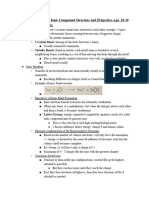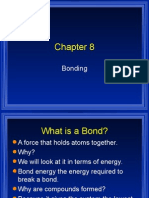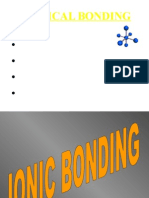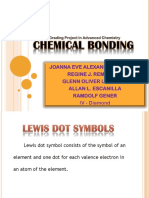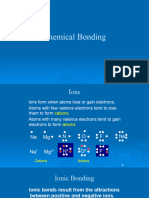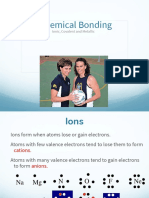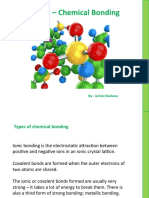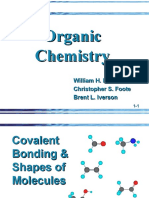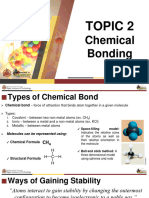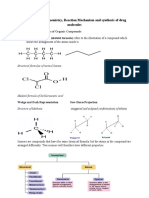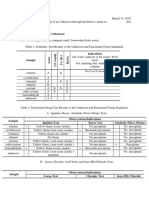Zumdahl Chapter 11
Uploaded by
prasetio widodoZumdahl Chapter 11
Uploaded by
prasetio widodoChemical Bonding
Chapter 11
Copyright©2004 by 1
Structure Determines Properties!
• A cardinal principle of chemistry is that the
macroscopic observed properties of a material are
related to its microscopic structure.
– And visa versa
• The microscopic structure entails
– the kinds of atoms
– the manner in which they are attached
– their relationship to other molecules, like and dislike
– the shape of the molecule
Copyright©2004 by 2
Chemical Bonds
• Forces that hold atoms together
• Ionic bonds are the forces of attraction
between ions
– ions formed by electron transfer
– electrostatic forces
• Covalent bonds are the forces of attraction
between two atoms which are sharing
electrons
Copyright©2004 by 3
Ionic Bonds
• Results from reaction between Metal and Nonmetal
• Metal loses electrons to form cation, Nonmetal gains electrons to
form anion
• Ionic bond is the attraction between a positive ion and negative
ion
• Larger Charge = Stronger Attraction
• Smaller Ion = Stronger Attraction
• No bond is 100% ionic!!
• Electrostatic attraction nondirectional
– no direct anion-cation pair, No ionic molecule
• chemical formula is empirical formula, simply giving the ratio of ions
based on charge balance
• Ions arranged in a pattern called a crystal lattice
• maximizes attractions between + and - ions
Copyright©2004 by 4
Covalent Bonds
• Typical of molecular substances
• Atoms bond together to form molecules
– strong attraction
• Sharing pairs of electrons
• Molecules attracted to each other weakly
• Often found between nonmetal atoms
Copyright©2004 by 5
Bond Polarity
• Covalent bonding between unlike atoms
results in unequal sharing of the electrons
– One end of the bond has larger electron density
than the other
• The result is bond polarity
– The end with the larger electron density gets a
partial negative charge
– The end that is electron deficient gets a partial
positive charge
δ+ H •• F δ−
Copyright©2004 by 6
Electronegativity
• Measure of the ability of an atom to attract shared
electrons
– Larger electronegativity means atom attracts more strongly
– Values 0.7 to 4.0
• Increases across period (left to right) on Periodic Table
• Decreases down group (top to bottom) on Periodic
Table
• Larger difference in electronegativities means more
polar bond
– negative end toward more electronegative atom
Copyright©2004 by 7
Copyright©2004 by 8
Dipole Moment
• Bond polarity results in an unequal electron distribution, resulting
in areas of partial positive and partial negative charge
• Any molecule that has a center of positive charge and a center of
negative charge in different points is said to have a dipole
moment
• If a molecule has more than one polar covalent bond, the areas of
partial negative and positive charge for each bond will partially
add to or cancel out each other
• The end result will be a molecule with one center of positive
charge and one center of negative charge
• The dipole moment effects the attractive forces between
molecules and therefore the physical properties of the substance
Copyright©2004 by 9
Copyright©2004 by 10
The three possible types of bonds: (a) a covalent bond formed
between identical atoms; (b) a polar covalent bond, with both
ionic and covalent components; and
(c) an ionic bond, with no electron sharing.
Copyright©2004 by 11
Electron Arrangements And Ion Charge
• We know
– Group 1A metals form ions with +1 charge
– Group 2A metals form ions with +2 charge
– Group 7A nonmetals form ions with -1 charge
– Group 6A nonmetals form ions with -2 charge
– Group 8A nonmetals do not form ions, in fact they
are extremely unreactive
Copyright©2004 by 12
Electron Arrangements and Ion Charge
• Representative Metals form
cations by losing enough
electrons to get the same
electron configuration as the
previous noble gas
• Nonmetals form anions by
gaining enough electrons to
get the same electron
configuration as the next
noble gas
Copyright©2004 by 13
Electron Arrangements and Ionic Bonding
• Representative metals lose their valence electrons to form
cations
• Nonmetals gain electrons so their valence shell has the
same electron arrangement as the next noble gas
• There have to be enough electrons from the metals atoms
to supply the needed electrons for the nonmetal atoms
– Allows us to predict the formulas of ionic compounds
• In Polyatomic ions, the atoms in the ion are connected
with covalent bonds. The ions are attracted to oppositely
charged ions to form an ionic compound
Copyright©2004 by 14
Properties of Ionic Compounds
• All solids at room temperature
– Melting points greater than 300°C
• Liquid state conducts electricity, solid state does not
– Liquid = molten
• Brittle and Hard
• Often soluble in water, and when dissolved the solution
becomes an electrical conductor
– When ionic compounds containing polyatomic ions dissolve, the
covalent bonds holding the polyatomic ion do not break, the ion
stays together even though it separates from the other ion
– All strong electrolytes
Copyright©2004 by 15
Bonding and Structure of Ionic Compounds
• Crystal Lattice = geometric pattern determined by the
size and charge of the ions
• Anions larger than cation
– Almost always
– Anions larger than parent atom, Cations smaller than parent atom
• Anions generally considered “hard” spheres packed as
efficiently as possible, with the cations occupying the
“holes” in the packing
• Arrangement results in each cation being surrounded by
as many anions as will fit
– And visa versa
– Maximizes attractions between ions
Copyright©2004 by 16
Lewis Symbols of Atoms and Ions
• Also known as electron dot symbols
• Use symbol of element to represent nucleus and inner
electrons
• Use dots around the symbol to represent valence electrons
– put one electron on each side first, then pair
• Elements in the same group have the same Lewis symbol
– Because they have the same number of valence electrons
• Cations have Lewis symbols without valence electrons
• Anions have Lewis symbols with 8 valence electrons
• •• •• •• ••
Li• Be• •B• •C• •N• •O: :F: :Ne:
• • • • • • ••
+1 •• ••
-1
Li• Li :F: [:F:]
• ••
Copyright©2004 by 17
Writing Lewis Structures of Molecules
• Count the total number of valence electrons from all the
atoms
• Attach the atoms together with one pair of electrons
– A line is often used as shorthand for a pair of electrons that attach
atoms together
• Arrange the remaining electrons in pairs so that all hydrogen
atoms have 2 electrons (1 bond) and other atoms have 8
electrons (combination of bonding and nonbonding)
• Occasionally atoms may violate this rule
– Nonbonding pairs of electrons are also know as Lone Pairs
Copyright©2004 by 18
Covalent Bonds
• Single Covalent Bond the atoms share 2 electrons,
– (1 pair)
• Double Covalent Bond the atoms share 4 electrons,
– (2 pairs)
• Triple Covalent Bond the atoms share 6 electrons,
– (3 pairs)
• Bond Strength = Triple > Double > Single
– For bonds between same atoms, C≡N > C=N > C—N
– Though Double not 2x the strength of Single and Triple not 3x the
strength of Single
• Bond Length = Single > Double > Triple
– For bonds between same atoms, C—N > C=N > C≡N
Copyright©2004 by 19
Problems with Lewis Structures
• Some atoms do not tend to follow the octet rule
– B and Be often found octet deficient
– Elements in the 3rd Period or below often have expanded octets
• Some molecules have an odd number of electrons
• Impossible to accurately draw Lewis structure of molecules
that exhibit resonance
• Sometimes the Lewis Structure does not accurately
describe a structure that explains all the observed
properties of the molecule
• The paramagnetic behavior of O2
Copyright©2004 by 20
Some Geometric Figures
• Linear 180°
– 2 atoms on opposite sides of central atom
– 180° bond angles
• Trigonal Planar
– 3 atoms form a triangle around the central
atom
– Planar 120°
– 120° bond angles
• Tetrahedral
– 4 surrounding atoms form a tetrahedron
around the central atom
– 109.5° bond angles
109.5°
Copyright©2004 by 21
Predicting Molecular Geometry
• VSEPR Theory
– Valence Shell Electron Pair Repulsion
• The shape around the central atom(s) can be predicted by
assuming that the areas of electrons on the central atom will
repel each other
• Each Bond counts as 1 area of electrons
– single, double or triple all count as 1 area
• Each Lone Pair counts a 1 area of electrons
– Even though lone pairs are not attached to other atoms, they do
“occupy space” around the central atom
– Lone pairs generally “push harder” than bonding electrons, affecting
the bond angle
Copyright©2004 by 22
Shapes
• Linear
– 2 areas of electrons around the central atom, both bonding
• Or two atom molecule as trivial case
• Trigonal
– 3 areas of electrons around the central atom
– All Bonding = trigonal planar
– 2 Bonding + 1 Lone Pair = trigonal bent
• Tetrahedral
– 4 areas of electrons around the central atom
– All Bonding = tetrahedral
– 3 Bonding + 1 Lone Pair = trigonal pyramid
– 2 Bonding + 2 Lone Pair = tetrahedral bent or V-shaped
Copyright©2004 by 23
The
tetrahedral
molecular
structure of
methane.
Copyright©2004 by 25
(a) the tetrahedral arrangement of electron pairs around the
nitrogen atom in the ammonia molecule. (b) Three of the
electron pairs around nitrogen are shared with the hydrogen
atoms as shown, and one is a lone pair. (c) The NH3 molecule
has the trigonal pyramid structure.
Copyright©2004 by 26
(a) The tetrahedral arrangement of the four electron pairs
around oxygen in the water molecule. (b) Two of the electron
pairs are shared between oxygen and the hydrogen atoms. (c)
The V-shaped molecular structure of the water molecule.
Copyright©2004 by 27
When liquid oxygen is poured between the poles of a
magnet, it “sticks” until it boils away.
Copyright©2004 by 28
You might also like
- Chapter - 7 Slides - General Chemistry - Open StaxNo ratings yetChapter - 7 Slides - General Chemistry - Open Stax96 pages
- Ionic and Covalent Bonding and Lewis StructuresNo ratings yetIonic and Covalent Bonding and Lewis Structures43 pages
- Chapter 2 - Atomic Structure and Interatomic Bonding - REVNo ratings yetChapter 2 - Atomic Structure and Interatomic Bonding - REV61 pages
- Chemical Bonding: Ionic Bonds Covalent Bonds Hydrogen Bonds Metallic BondsNo ratings yetChemical Bonding: Ionic Bonds Covalent Bonds Hydrogen Bonds Metallic Bonds84 pages
- Chapter 4 Co-Valent bonding, shapes of moleculesNo ratings yetChapter 4 Co-Valent bonding, shapes of molecules35 pages
- LECTURE 3-FunctionaL Groups and Water PropertiesNo ratings yetLECTURE 3-FunctionaL Groups and Water Properties92 pages
- Lecture - 05 - Chemical Bonding I Basic ConceptsNo ratings yetLecture - 05 - Chemical Bonding I Basic Concepts55 pages
- Chemical Bonding and Chemical StructureNo ratings yetChemical Bonding and Chemical Structure93 pages
- CMY 117 Theme 5 Bonding and molecular geometry Student Notes(3)No ratings yetCMY 117 Theme 5 Bonding and molecular geometry Student Notes(3)88 pages
- Lecture 7 & 8 - Basic Concepts of Chemical BondingNo ratings yetLecture 7 & 8 - Basic Concepts of Chemical Bonding37 pages
- Chapter 10: Chemical Bonding: Lewis TheoryNo ratings yetChapter 10: Chemical Bonding: Lewis Theory16 pages
- Chapter 2 Atomic Strucure and Bonding Lim YC_studentNo ratings yetChapter 2 Atomic Strucure and Bonding Lim YC_student47 pages
- Unit 3: Chemical Bonding and Molecular Structure100% (2)Unit 3: Chemical Bonding and Molecular Structure41 pages
- Chemical Bonding and Molecular StructureNo ratings yetChemical Bonding and Molecular Structure33 pages
- The Feica-Asc Adhesives & Sealants Classification ManualNo ratings yetThe Feica-Asc Adhesives & Sealants Classification Manual17 pages
- Synthesis of Bactericidal Microfiltration Ceramic MembranesNo ratings yetSynthesis of Bactericidal Microfiltration Ceramic Membranes14 pages
- Chemical Analysis of Magnesium and Magnesium Alloys: Standard Test Methods ForNo ratings yetChemical Analysis of Magnesium and Magnesium Alloys: Standard Test Methods For18 pages
- GLG 333 - Igneous Textures and Structures: Microcrystalline. Individual Crystals Large Enough To Be Seen Easily With ANo ratings yetGLG 333 - Igneous Textures and Structures: Microcrystalline. Individual Crystals Large Enough To Be Seen Easily With A3 pages
- Recent development in water-based resins for surface coatings 1988No ratings yetRecent development in water-based resins for surface coatings 198831 pages
- Student Name Title Thesis Adviser GRP No.: Chemical and Food Engineering DepartmentNo ratings yetStudent Name Title Thesis Adviser GRP No.: Chemical and Food Engineering Department2 pages
- Chemistry: Form 5 First Term Examination 2011No ratings yetChemistry: Form 5 First Term Examination 201110 pages
- Unit - IV: Stereochemistry, Reaction Mechanism and Synthesis of Drug MoleculesNo ratings yetUnit - IV: Stereochemistry, Reaction Mechanism and Synthesis of Drug Molecules8 pages
- Chemistry 123S Oregon State University Worksheet 9 Notes Dr. Richard NafshunNo ratings yetChemistry 123S Oregon State University Worksheet 9 Notes Dr. Richard Nafshun11 pages
- Subjective Mock Test 02 _ Test Paper (Chemistry) __ Hope (Backlog Series)No ratings yetSubjective Mock Test 02 _ Test Paper (Chemistry) __ Hope (Backlog Series)2 pages
- Biotechnological_Processes_for_Green_Energy,_and_High_Value_BioproductsNo ratings yetBiotechnological_Processes_for_Green_Energy,_and_High_Value_Bioproducts252 pages
- Solubilty Product (K) : A B + Aq Aa + BBNo ratings yetSolubilty Product (K) : A B + Aq Aa + BB6 pages
- A Student s Guide to Maxwell s Equations 1st Edition Daniel Fleisch - Download the full set of chapters carefully compiled100% (1)A Student s Guide to Maxwell s Equations 1st Edition Daniel Fleisch - Download the full set of chapters carefully compiled47 pages
- Granular Media Gas Phase Filtration SystemsNo ratings yetGranular Media Gas Phase Filtration Systems2 pages
- Aerated Concrete: A Revolutionary Construction Material: April 2018No ratings yetAerated Concrete: A Revolutionary Construction Material: April 20187 pages
- Exp 4 Postlab Worksheet Identification of An Unknown Through Qualitative AnalysisNo ratings yetExp 4 Postlab Worksheet Identification of An Unknown Through Qualitative Analysis4 pages













